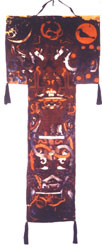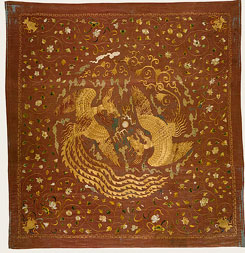History of Embroidery: China
Hunan Xiang Embroidery |
Changsha Mawangdui Han Toms |
|
Xiang embroidery, is world famous for its technics and long history. Xiang is the shortened form for Hunan Province. Archeologists have discovered finely embroidered silk items in Changsha Mawangdui Han Toms (206BC-220AD), indicating that more than 2,000 years ago Xiang embroidery craftwork had emerged. During the long process of development, Xiang embroidery adopted the techniques used in traditional Chinese painting and formed its own unique style. By the end of the Qing Dynasty (the early 20th century), the technics of Xiang embroidery reached its peak and even took the leading position, surpassing Su embroidery. Xiang embroidery is famous for its tiger patterns. Xiang embroidery's unique techniques are generally based on Chinese painting, although it also includes techniques of engraving, calligraphy, and embroidery. This combination of techniques produced a new and unique embroidery product, double-faced and with different images and colors on each side of a transparent chiffon, greatly uplifting the artistic value of Xiang embroidery. The main threads used include pure silk, satin, transparent gauze and nylon, etc |
 |
Forty-nine changes of clothes were retrieved from Xin Zhui's tomb, most of them impeccably preserved, and represent perhaps the most spectacular of the tomb's many treasures. Among the fabrics are pearl-white ramie, loosely woven hemp, and brushed cotton -- not to mention an impressive array of silks. Verdant silk shoes, silk gloves embroidered with migrant birds, and a transparent gauze silk robe are only a few objects found in the Marquise's armoire. Even more impressive are the silk garments decorated with exquisite raised-thread brocade designs. Larger cross-shaped funerary banners display an entire theatrical scene, and offer insights into the complex social, political, and cosmological worlds of early Han Dynasty culture. |
| Canopy with phoenixes, Yuan dynasty (1279–1368) Metropolitan Museum of Art, New York. |  |
